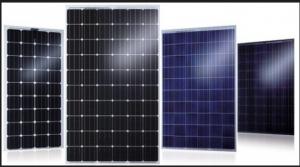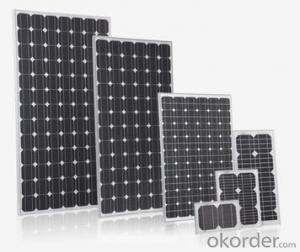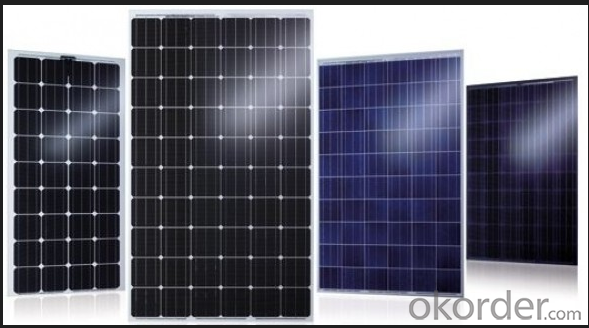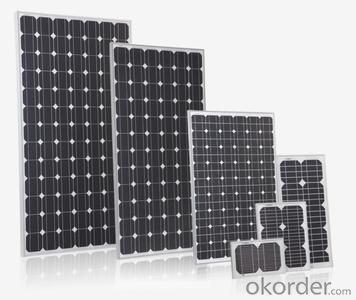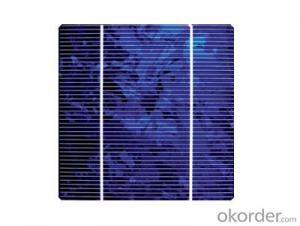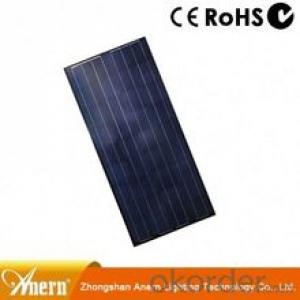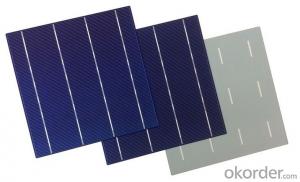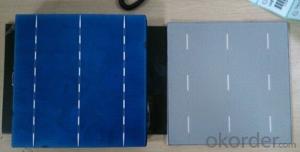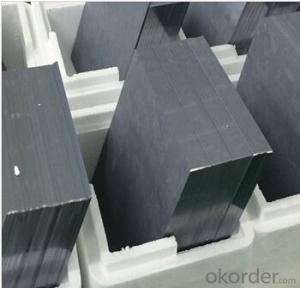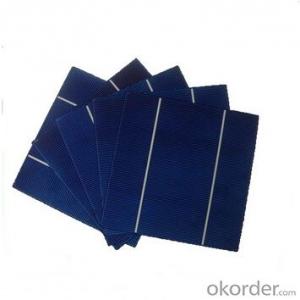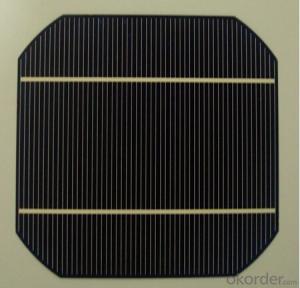Triple Junction Silicon Solar Cell 156mm*156mm with Different Efficiency
- Loading Port:
- China main port
- Payment Terms:
- TT or LC
- Min Order Qty:
- 100 m.t.
- Supply Capability:
- 10000000 m.t./month
OKorder Service Pledge
OKorder Financial Service
You Might Also Like
Description:
CNBM Solar is a world-leading and Vertical integrated manufacturer of high-performance with Silicon,
Wafer, Cells, Modules, which convert sunlight into electricity for residential, commercial, and utility-scale
power generation.
The capacity of CNBMSolar is reach to 1GW, and make sure each year our shipment capacity is more
Than 700-800MWs, at the same time, we have set up the largest solar power station with our partner
in Ukraine.
CNBM is a Quality + Service oriented company with“Excellence at Each Step” approach, composed of
the finest components from TUV and IEC-certified partners around the world, CNBM modules consistently
undergo a variety of trials at the company’s Test & Development Centre, ensuring peak performance
capabilities. The company is committed to develop and provide the world with clean and renewable energy
to ease the energy shortages as well as human kind’s impact on the environment.
Packaging & Delivery
| Packaging Detail: | Typical package for one carton contains 1,200 cells.The cells are sealed in cell box every 100pcs.Gross weight peri unit carton shall be around 17.1Kg. |
| Delivery Detail: | Within 1-2days after received payment |
Specifications
*High efficiency and High power
*Long-term electrical stability
*Best quality
*fast ship
156mm Multi-Crystalline Silicon Solar Cell low price, high efficiency for solar panels/ modules
PHYSICAL
Dimension: 156mm x 156mm ± 0.5mm
TYPICAL ELECTRICAL CHARACTERISTICS
| Efficiency | 1640 | 1660 | 1680 | 1700 | 1720 | 1740 | 1760 |
| Efficiency(min)% | 16.4 | 16.6 | 16.8 | 17.0 | 17.2 | 17.4 | 17.6 |
| Pmax(W) | 3.991 | 4.040 | 4.088 | 4.137 | 4.186 | 4.234 | 4.283 |
| Voc(V) | 0.623 | 0.626 | 0.629 | 0.631 | 0.633 | 0.635 | 0.637 |
| Isc(A) | 8.412 | 8.455 | 8.506 | 8.557 | 8.602 | 8.643 | 8.681 |
| Vmp(v) | 0.515 | 0.517 | 0.520 | 0.522 | 0.524 | 0.526 | 0.527 |
| Imp(A) | 7.750 | 7.814 | 7.862 | 7.926 | 7.988 | 8.050 | 8.127 |
*Data under standard testing conditional (STC):1,000w/m2,AM1.5, 25°C , Pmax:Positive power tolerance.
TYPICAL TEMPERATURE Voltage -2.14 mV/K
COEFFICIENTS Current +4.93 mA/K
Power -0.43 %/K
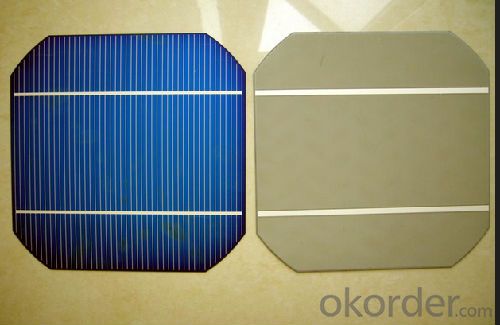
FAQ:How to PACK?
Typical package for one carton contains 1,200 cells.The cells are sealed in cell box every 100pcs.Gross weight peri unit carton shall be around 17.1Kg.
- Q: How do solar cells handle electrical noise or interference?
- Solar cells are not affected by electrical noise or interference as they directly convert sunlight into electricity without relying on external sources of power or signals. They operate independently and are not susceptible to the same issues that can disrupt other electrical systems.
- Q: Can solar cells be used to power air conditioning systems?
- Yes, solar cells can be used to power air conditioning systems. Solar panels can generate electricity from sunlight, which can then be used to power various appliances including air conditioning units. This offers a sustainable and renewable energy solution, reducing reliance on traditional power sources and contributing to a greener environment. However, it is important to note that the efficiency and capacity of solar cells may limit their ability to fully power larger air conditioning systems.
- Q: Can solar cells be used in off-grid systems?
- Yes, solar cells can be used in off-grid systems. Off-grid systems typically rely on renewable energy sources, and solar cells are an ideal choice for generating electricity in such systems. Solar cells convert sunlight into electricity, which can be stored in batteries for use when the sun is not shining. This allows off-grid systems to power various appliances and devices without the need for a connection to the traditional power grid.
- Q: Can solar cells be used in powering medical devices?
- Yes, solar cells can be used to power medical devices. Solar cells can convert sunlight into electricity, which can then be used to directly power or recharge batteries of various medical devices such as pacemakers, insulin pumps, and portable diagnostic equipment. This renewable energy source offers a sustainable and efficient solution for powering medical devices, especially in remote or resource-limited areas where access to electricity may be limited.
- Q: Can solar cells work in cloudy weather?
- Yes, solar cells can still work in cloudy weather, although their efficiency may be reduced. Clouds diffuse sunlight, causing a decrease in the amount of direct sunlight reaching the solar cells. However, solar cells can still generate electricity from the diffused sunlight, although at a lower rate compared to sunny conditions.
- Q: Can solar cells be used in public transportation systems?
- Yes, solar cells can be used in public transportation systems. They can be integrated into vehicles such as buses, trams, and trains to generate electricity from sunlight, reducing reliance on conventional energy sources and lowering carbon emissions. Solar-powered public transportation systems have been successfully implemented in various cities around the world, demonstrating the feasibility and benefits of using solar cells in this sector.
- Q: Can solar cells be used to power electronic devices?
- Yes, solar cells can be used to power electronic devices. Solar cells convert sunlight into electricity, which can then be used to power a wide range of electronic devices such as smartphones, laptops, calculators, and even larger appliances like refrigerators or streetlights. This allows for a sustainable and renewable source of energy for various applications.
- Q: What is the maximum efficiency that a solar cell can achieve?
- The maximum efficiency that a solar cell can achieve is known as the Shockley-Queisser limit, which is approximately 33.7%. However, in practical applications, the efficiency of commercial solar cells typically ranges between 15-22%.
- Q: Can solar cells be used in marine applications?
- Yes, solar cells can be used in marine applications. They can be integrated into boats, yachts, and other marine vessels to generate electricity from sunlight, which can be used to power various onboard systems and equipment. Additionally, solar cells can also be used to charge batteries, providing a reliable and sustainable source of energy for marine applications.
- Q: What is the average cost of a solar cell?
- The average cost of a solar cell can vary depending on factors such as the type and size of the cell, the manufacturer, and the region. However, as of 2021, the average cost ranges from $0.20 to $0.80 per watt for photovoltaic solar cells.
Send your message to us
Triple Junction Silicon Solar Cell 156mm*156mm with Different Efficiency
- Loading Port:
- China main port
- Payment Terms:
- TT or LC
- Min Order Qty:
- 100 m.t.
- Supply Capability:
- 10000000 m.t./month
OKorder Service Pledge
OKorder Financial Service
Similar products
Hot products
Hot Searches
Related keywords
